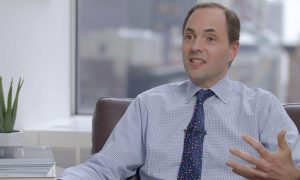by Charles Bilello, Pension Partners
“The assets always peak with the peak in performance, because if the performance kept up, the assets would keep going up.” – Bill Miller on Masters in Business with Barry Ritholtz
It was early 2015 and life was good at the MainStay Marketfield Fund. So good in fact that its parent company (New York Life) was busy looking for the “Next Marketfield”…
“The Marketfield Fund, run by Michael Aronstein, had about $2 billion under management when New York Life agreed to add it. Marketfield, which can bet on share declines and use options, now oversees more than $20 billion, making it New York Life’s largest mutual fund.
“You marry up a hot asset class with really strong performance with great distribution, and that’s what happens,” John Kim (chief investment officer) said.
“If there are other Marketfields and Cushings of the world out there, we would be interested,” Kim, 53, said in an interview this week in his Manhattan office. “We’re looking to fill out the suite of alternative capabilities even more.”
From $2 billion to over $20 billion in AUM in … less than 2 years. An incredible growth story. Who could blame New York Life for wanting to repeat this?
But how did they get there? A combination of two important factors…
1) Near the end of 2013, Marketfield had beaten “97 percent of its peers over the previous five years.” During this time, its shares had more than doubled.
And so, investors did what they do best: chase past returns.
2) Marketfield was also in the long/short equity category, a so-called “liquid alternative.” Such funds were all the rage at the end of 2013, with assets moving up to $132 billion from only $36 billion in 2008.
And so, investors did what they do best: buy what everyone else is buying (herding instinct).
“You marry up a hot asset class with really strong performance with great distribution, and that’s what happens.”
Indeed, that is what happens.
But what happens after that happens? That is the question.
Did the “really strong performance” continue?
No. Marketfield would finish 2014 down 12.3%, 2015 down 8.3%, and 2016 down 3.4%. The cumulative losses over that period exceeded 22% with a maximum drawdown of 28%. During the past 3 years, the fund has underperformed 97% of its peers.
How many investors chose to stick around during this period of underperformance?
Few. After peaking at over $22 billion in early 2014, assets today stand at just over $600 million. That’s a 97% decline.
Did MainStay (New York Life) ever find the next Marketfield?
As of today, there is no reporting of such a finding and MainStay decided to sell the fund back to Marketfield Asset Management in 2016.
Did the “hot asset class” known liquid alternatives continue to be hot?
No, as performance has waned, the sector as a whole has experienced large outflows and in 2016 saw more fund liquidations than launches.
What is the “Hardest Thing?”
Outperforming passive benchmarks after fees is very hard. Many studies have documented just how hard, showing that few active funds beat such benchmarks over a long period of time. That said, outperforming is not the hardest thing; there is something much harder.
The hardest thing in the investment business is seeing your investors (in aggregate) actually benefit from any of your outperformance. This is so difficult because it requires your investors to behave unemotionally in their buy/sell decisions and not chase past performance to their detriment.
As we know, though, most investors behave veryemotionally, buying high only after periods of outsized performance, and selling low only after periods of underperformance. That is precisely what happened in the case of the Marketfield Fund.
In doing so, the dollar-weighted (or investor) returns for even the best funds often trail the fund’s return by a wide margin. Perhaps the best example of this in history was the “fund of the decade” from 2000-09: CGM Focus. The Fund gained over 18% annually during the decade (more than 3% better than its closest rival) while its shareholders lost 11% annually.
This so-called “behavior gap” has become so ingrained in the business that most managers simply throw their hands up and say: “what can you do.” “You’re not going to change investor behavior,” they say, “so focus on something else” (that something else is often marketing whatever product is hottest). The standard thinking has become “chasers gonna chase so take their money when you’re doing well and hope to hold onto to it long enough to profit from it.”
Call me naïve, but we can do better than that. No, we need to do better, for if even the best active funds get the vast majority of their investors to invest only after periods of outperformance, what is the point of active management? How is that benefiting anyone (in aggregate) but the manager earning fees off it? If that’s the sad reality and there’s nothing anyone can do about it, it’s hard to argue that the massive wave from active to passive will not and should not continue.
Is there any answer to this industry-wide problem?
There are certainly no easy answers here because you are dealing with psychology and behavior that is not easy to change. People buy and sell past returns not because they are stupid but because they are wired to do so.
The only way to have a chance at closing the behavior gap, then, is through education, re-education, and more re-education:
- By teaching your investors about the inherent cyclicality of all factors/strategies and therefore all fund returns (even the very best funds underperform and for long periods).
Source: The Truth About Top-Performing Mutual Fund Managers, AAII Journal, July 2011
- By teaching your shareholders that there will be many painful drawdowns along the way; there is no reward without risk (even the great Warren Buffett had two 50% drawdowns).
- By teaching your shareholders that your fund should be only one part of a diversified portfolio, and that not everything in your portfolio should be “working” at all times.
- By teaching your shareholders that selecting funds based on 3-year past performance (buying the best, selling the worst) is not an effective investment strategy.
- By setting realistic expectations in terms of magnitude and timing performance and your ability to predict such things (you can’t).
Is it possible to close the gap, even just a little bit?
I hope so. I realize that efforts to educate will in the aggregate fall short (emotions trump education most of the time) and that many will therefore dismiss such efforts as an act of futility. But that doesn’t mean we shouldn’t try. For protecting investors from themselves is not just the hardest thing in the business, it is also the most important thing.
Which is why the story of Marketfield needed to be told.
*****
This writing is for informational purposes only and does not constitute an offer to sell, a solicitation to buy, or a recommendation regarding any securities transaction, or as an offer to provide advisory or other services by Pension Partners, LLC in any jurisdiction in which such offer, solicitation, purchase or sale would be unlawful under the securities laws of such jurisdiction. The information contained in this writing should not be construed as financial or investment advice on any subject matter. Pension Partners, LLC expressly disclaims all liability in respect to actions taken based on any or all of the information on this writing.
CHARLIE BILELLO, CMT
Charlie Bilello is the Director of Research at Pension Partners, LLC, an investment advisor that manages mutual funds and separate accounts. He is the co-author of four award-winning research papers on market anomalies and investing. Mr. Bilello is responsible for strategy development, investment research and communicating the firm’s investment themes and portfolio positioning to clients. Prior to joining Pension Partners, he was the Managing Member of Momentum Global Advisors and previously held positions as a Credit, Equity and Hedge Fund Analyst at billion dollar alternative investment firms.
Mr. Bilello holds a J.D. and M.B.A. in Finance and Accounting from Fordham University and a B.A. in Economics from Binghamton University. He is a Chartered Market Technician (CMT) and a Member of the Market Technicians Association. Mr. Bilello also holds the Certified Public Accountant (CPA) certificate.
Copyright © Pension Partners





























